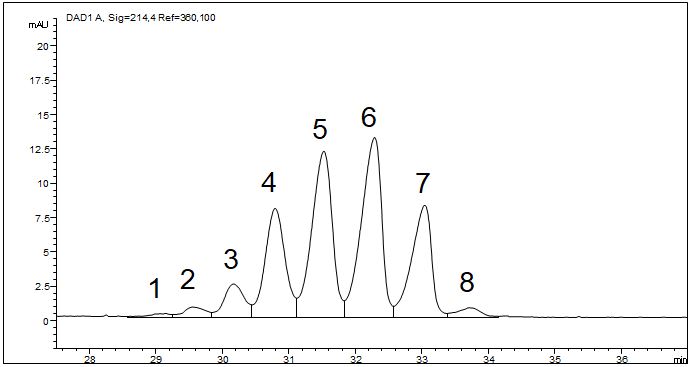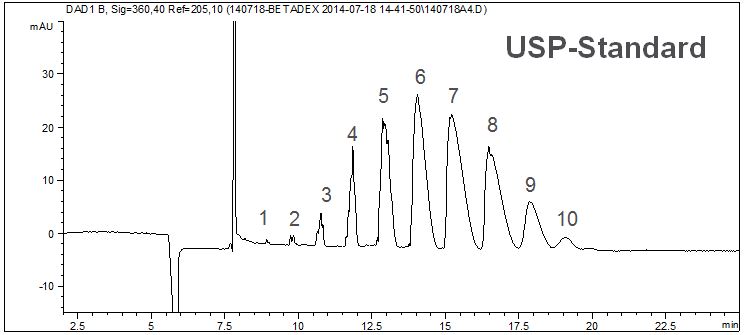Some applications for capillary electrophoresis are described in EP or USP. Several of these applications are presented in the following chapters.
EPO – Erythropoietin (EP-Monograph No.: 1316)
CAS-Nr: 113427-24-0
EPO is a glycoprotein consisting of 165 aminoacids.
The method corresponds to the European Pharmacopoeia, monograph number 1316. The following experimental conditions were applied:
- CE mode: CZE
- Electrolyte: according to PhEur
- Capillary: fused silica, 50 µm ID, 64.5 cm total length
- Temperature: 35°C
- Injection: hydrodynamic
- Detection: direct UV, 214 nm
- Separation: + 9.2 kV
- Description: The determination of the different glycoforms of EPO is done according to EP monography No.1316. Separation and detectability are given for eight isomers. Hint: In the Monograph a capillary length of about 100 cm is given. However, by adjusting the voltage to maintain the appropriate field strength the use of shorter capillaries is possible, leading to shorter analysis times and higher sensitivity.

EPO – Erythropoietin
In the PDF the e-gram of the EPO standard solution is shown. Further a table with the peak area% for the eight glycoforms is given.
Download (167 KB): EPO.pdf
Glutathione – Purity
Glutathione (GSH) is an antioxidant in plants, animals, fungi, and some bacteria and archaea. Glutathione is capable of preventing damage to important cellular components caused by reactive oxygen species such as free radicals, peroxides, lipid peroxides, and heavy metals. Because of its antioxidant effect, glutathione is used as a dietary supplement.
- Synonyms:
- 2-Amino-5-{[1-((carboxymethyl)amino)-1-oxo-3-sulfanylprop-2-yl]amino}-5-oxovaleriansäure
- γ-L-Glutamyl-L-cysteinyl-glycin
- GSH, ECG
- [70-18-8]
The method corresponds to the European Pharmacopoeia, monograph number 1670. The following experimental conditions were applied:
- CE mode: CZE
- Electrolyte: Phosphate, pH 1.8 (adjusted with phosphoric acid (85 %) to fulfill the SST)
- Capillary: fused silica, 75 µm ID, 64.5 cm total length
- Temperature: 25°C
- Injection: 5 s, 50 mbar
- Detection: direct UV, 200 nm
- Separation: 20 kV
- Description: The method is used for testing the purity of glutathione by determining the related substances L-cysteinylglycine, L-cysteine, L-glutathione oxidized, L-y-glutamyl-L-cysteine and unspecified impurities. The quantification is performed using L-phenylalanine as internal standard.
In the PDF (520 KB) the e-grams of the SST solution and one sample solution are shown. Further a table with the specification data of all impurities is given.
Download (520 KB):Glutathione – purity
Betadex (SBE-β-CD)
- Separation: CZE
- Electrolyte: benzoic acid with Tris
- Capillary: fused silica, 50 µm ID, 50 cm in total
- Temperature: 25°C
- Injection: 10 s, 34 mbar
- Detection: indirect UV, 205 nm
- Description: This method describes the determination of the distribution of the substitution of sulfobutylether-β-cyclodextrin (SBE-β-CD). Ten different levels of substitution are checked. The resulting peak areas are normalized and evaluated against the defined values.
Download: Betadex.pdf
S-Ropivacaine hydrochloride monohydrate – Determination of enantiomeric purity
- Separation: MEKC
- Electrolyte: Heptakis-(2,6-di-O-methyl)-β-cyclodextrin, phosphoric acid and Triethanolamine, pH 3.0
- Capillary: fused silica, 50 µm ID, 81,5 cm in total
- Temperature: 30°C
- Injection: 10 s, 50 mbar
- Detection: direct UV, 206 nm
- Description: The aim of the analysis is the determination of the enantiomeric purity of S-ropivacain with regard to R-ropivacain. For SST the resolution and the limit of detection of the enantiomers is determined.
Download: Ropivacain-SST.pdf
S-Ropivacaine hydrochloride monohydrate – Sample
- Separation: MEKC
- Electrolyte: Heptakis-(2,6-di-O-methyl)-β-cyclodextrin, phosphoric acid and Triethanolamine, pH 3.0
- Capillary: fused silica, 50 µm ID, 81,5 cm in total
- Temperature: 30°C
- Injection: 10 s, 50 mbar
- Detection: direct UV, 206 nm
- Description: For the sample the enantiomeric purity of S-ropivacain with regard to R-ropivacain was tested.
Download: Ropivacain-Probe.pdf
Somatropin – Determination of purity
- Separation: CZE
- Electrolyte: Diammoniumhydrogenphosphate with phosphoric acid, pH 6,0
- Capillary: fused silica, 50 µm ID, 64,5 cm in total
- Temperature: 30°C
- Injection: 4 s, 50 mbar
- Detection: direct UV, 200 nm
- Description: In total four impurities are recorded. On the basis of the SST it has to be proved that impurity I1 and I2 migrate before the main peak and I3 and I4 migrate after the main peak. Impurity I4 is the deamidated form, which migrates as a double peak. The assignment is made by means of the relative migration times.
Download: Somatropin-SST




